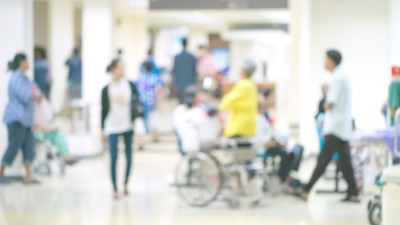Preventive Detection and Avoidance of Dangers and Risks in Hospitals and Clinics

The figures speak for themselves: crime rates are surging in clinics and hospitals. To prevent trouble, those in charge need to take preventive action. Integrated security concepts and networked solutions can help.
The smoke detectors, for example, may have been installed by a local electrical goods supplier, while access control is handled by a security firm - hospital security systems are typically a hodgepodge of individual solutions. It’s commonplace for hospitals to purchase a video surveillance system from a nearby dealer and operate it without outside help. And so on. But requirements are increasing, and with them the importance of having an integrated solution to ensure that all involved players take effective, coordinated action.
New challenges are posed, for instance, by falling thresholds for aggression and violence, widespread substance abuse, and organized theft of medical equipment. Increased vigilance is also necessitated by increasingly strict fire protection and hygiene regulations, compounded by the mounting cost pressures that all hospitals face.
Hospitals and their staff are exposed to a particularly large number of different risks

In this age of technology and digitization, most hospitals have acquired expensive instruments and equipment. Organized bands of thieves have specialized in preying on these valuable objects, especially small, costly and universally usable devices.
Types of Threats
In many cases, hospital administrators are ignorant of where and how their staff, patients and infrastructure may be at risk. It’s helpful to categorize the dangers and counter them with a comprehensive package of measures. The threats can include violence against individuals, burglary and theft, vandalism, arson and attacks.
These threats are real and deserve to be taken seriously, as is plain not only from reports in the media but also from the growing volume of published research studies on violence in hospitals. According to PubMed, a medical search engine, their number has more than doubled over the last decade. The studied behaviors include relatively harmless verbal attacks, but also extend to physical aggression, arson and even kidnapping of children.
Several millions of euros
costs the damage caused by the theft of endoscopes in several hospitals in the German state of North Rhine-Westphalia.
Our solutions to guarantee security in hospitals
Individual Concepts
Access control provides a good example of how precisely solutions need to be tailored to conditions at a particular institution. A relatively small hospital with 300 beds and a single entrance is naturally easier to monitor than a large hospital complex with several entrances and/or multiple buildings. This makes it imperative to proceed thoroughly and sensitively. The first step is to develop personnel and organizational solutions, which are then supplemented and supported by technical systems in a second step.
Personnel and Organizational Measures
A comprehensive security concept includes training courses for personnel, plans for dealing with emergencies, and consistently enforced, up-to-date house rules. Often there is no alternative to hiring a security service, although this has its price: in Germany, three security guards can cost around 250,000 euros a year.
A comprehensive security concept includes training courses for personnel, plans for dealing with emergencies, and consistently enforced, up-to-date house rules. Often there is no alternative to hiring a security service, although this has its price: in Germany, three security guards can cost around 250,000 euros a year.
Technical Measures
With increasing digitization, there are now technologies able to identify situations that could potentially lead to violence or aggression and proactively send findings to responsible individuals. A security service can’t be everywhere at once, but video surveillance can. Of course, this only works if images aren’t displayed on random monitors but all together in a central control station where, ideally, they are also automatically evaluated. Intelligent video analysis saves security guards work because warnings can be automatically issued, eliminating the need to constantly watch multiple screens. This technology is especially well-suited for sensitive areas like emergency departments and large, complex or chaotic wards. The inherent drawback of video monitoring is that events aren’t captured and displayed until it is too late to prevent them.
Cameras are therefore increasingly being supplemented with technologies able to autonomously detect dangerous situations before they erupt into violence. Audio analysis is especially effective for this. In 90% of cases, physical violence is preceded by verbal aggression. If this is detected and reported in time, a security guard can preventively intervene before anything serious happens. Solutions of this kind are already proving their value in everyday hospital situations. Although they are only available from system specialists with expertise in digitally networking different technologies, headway is being made. According to a study by the Roland Berger consulting firm, close to 90% of hospitals are already working on a digitization strategy. Most of them, however, have a long path to travel before they can genuinely call themselves smart hospitals.
With our solutions, doctors and hospital staff can devote themselves entirely to the patient

Integrated Approaches with Networked Systems
Bosch Energy and Building Solutions offers modular security approaches that can be scaled as appropriate depending on the potential dangers and a healthcare facility’s size and budget.
It starts with a consulting and planning phase in which the on-site conditions, potential dangers and risks, and a hospital’s possibilities and goals are all taken into account. This is followed by installation work and later, if wished, maintenance and servicing of all systems supplemented by conventional and digital services. A scenario comprising the following solutions is already conceivable today:
- sensors installed at doors and windows,
- networked motion sensors or
- intrusion alarm systems,
- voice alarms and
- intelligently controlled lighting solutions.
A major benefit is that already existing cameras, sensors and systems can be integrated into the new, comprehensive setup. This reduces the required investments.
- sensors installed at doors and windows,
- networked motion sensors or
- intrusion alarm systems, voice alarms and intelligently controlled lighting solutions.
Data privacy comes first in all control and communication solutions. Here too, a system integrator with a holistic approach can help by sitting down with managers, personnel, the staff council etc. to explain the advantages and flexibility gains of a networked security concept, illustrating them with best practices.
Bosch is also working with partners to develop other IoT-based services for smart hospitals. They include indoor solutions for localizing mobile medical equipment. To enable this, each device is fitted with sensors that transmit its position and state, e.g. its battery level, to a control center. This way staff can always quickly and easily locate and request required equipment. Intelligent access control also increases security and availability.
Contactless sensors automatically detect the location and access authorizations of physicians and nurses, thus eliminating the need to laboriously enter codes or read cards by hand. All staff can also be immediately contacted at any time via an internal communication system. All of the data come together in a central control station where they can be automatically processed or relayed as appropriate.
Summary
At the end of the day, the investment pays off handsomely for everyone concerned. Patients feel safer and better looked after, and staff can work with greater confidence and reduced stress levels.

